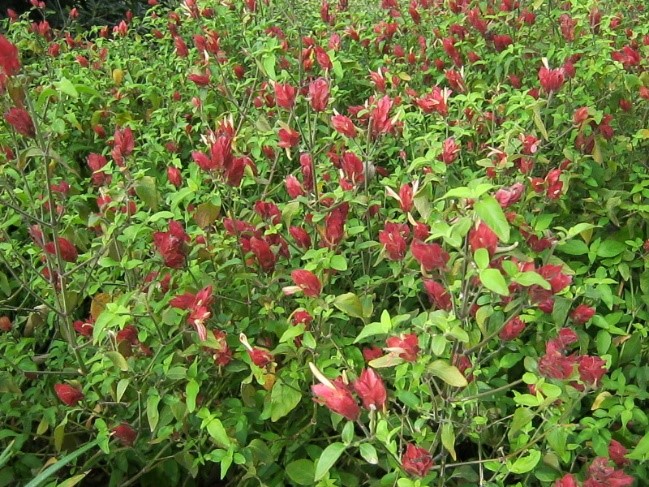(Justicia brandegeeana)
By Tera Marshall, Bexar County Master Gardener
Shrimp plants are a must-have for any pollinator garden! They are drought tolerant once established, bloom from June until frost and attract tons of bees! They also freeze back to the ground and come back from the roots, even from our 10° freeze last year (and don’t need to be covered in winter). They grow into a large shrub and get bigger and better every year!
Shrimp plant is unique in its blossoms. The showy red to salmon–colored bracts sport a dashing white flower accent. From a distance, the blossoms resemble a cooked shrimp, which explains its name. It is also called False Hop or Mexican Shrimp Bush.

Photo credit relandsdailyfacts.com
Size: They grow from 18” to 60” tall, and will spread out over years, if they aren’t contained in an area. Shrimp plant also grows well in containers. It is a perennial that comes back every year from the roots and will get taller and bushier every year.
Planting: They can be purchased at many nurseries in 1-gallon pots. Some varieties have variegated leaves, although to tell you the truth, they aren’t very much different from the non-variegated kind. I have some side by side and it is difficult to tell the difference. It will bloom most consistently if planted in full sun, although it will tolerate partial shade. It will just bloom less in shade. The blossoms will be much more vibrant if you can plant them where they will have strong morning sun and some afternoon shade.
It is recommended to fertilize with slow-release fertilizer in the spring, and then apply water soluble fertilizer through the summer months. I usually forget to apply the water soluble, and mine do just fine without it.

Pinching: Shrimp plant is a plant that will benefit from spring pinching. Although that will delay blooming a month or so, you’ll have twice as many blooms when it does bloom. And the blossoms will last until a freeze.
Propagation: Shrimp plant can be easily propagated from cuttings in the spring. Take a 6-inch stem tip cutting, remove lower leaves, and remove any blossoms. You want to leave only a few small leaves at the top. Dip in rooting hormone, plant in a loose soil mixture, and cover to keep the humidity in. Keep the soil moist and keep in indirect light. It will develop roots within about 2 months. You will know it has rooted when it starts putting out new leaves. Then pot it up, let it grow some more and plant in the soil or its permanent container. You can also use a landscape staple to pin a branch from an established shrub into the soil, cover the joints with soil, and just let it grow, watering it when you water your shrub. The joints will develop roots, and when they have, you can cut the new plant free from the mother plant.

A large shrimp plant can also be propagated by dividing. After it has frozen to the ground, cut all the dead branches to a few inches long, take a sharp shovel and just dig out an area of root from the edge of the shrub. Fill in the hole with soil. The roots you dug out can then be potted or replanted somewhere else. Water regularly until established.
Get yourself a Shrimp plant or propagate from a friend’s plant. You are certain to enjoy this wonderful bee and butterfly magnet all summer long!
Additional information: http://ekps.tamu.edu/details?id=200
